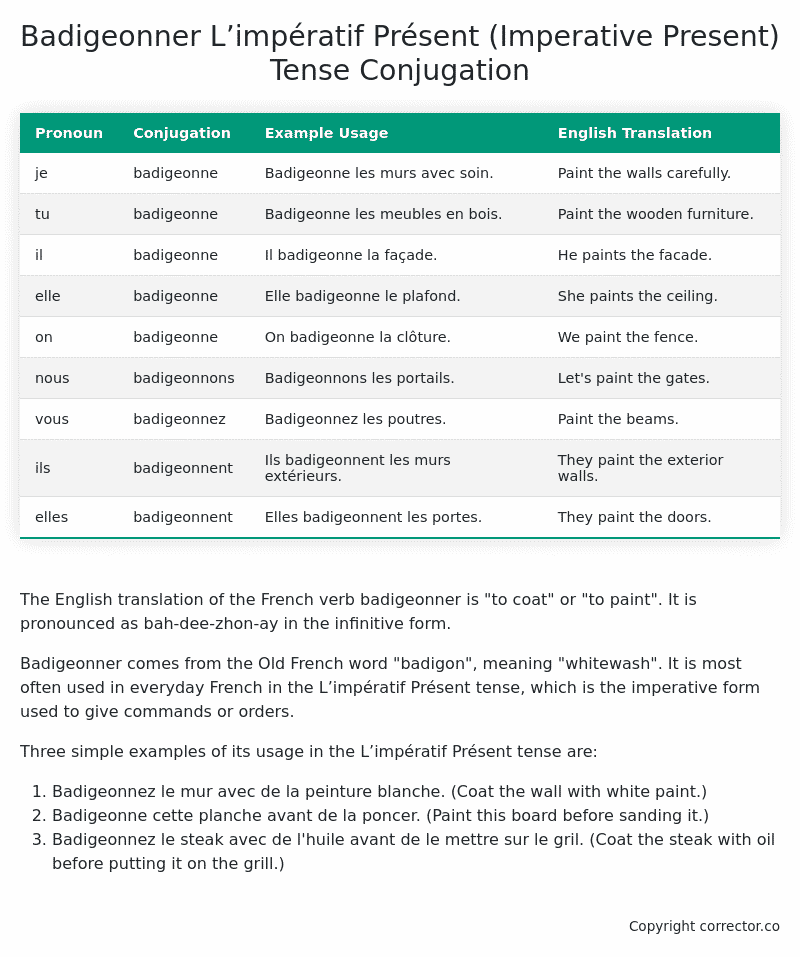L’impératif Présent (Imperative Present) Tense Conjugation of the French Verb badigeonner
Introduction to the verb badigeonner
The English translation of the French verb badigeonner is “to coat” or “to paint”. It is pronounced as bah-dee-zhon-ay in the infinitive form.
Badigeonner comes from the Old French word “badigon”, meaning “whitewash”. It is most often used in everyday French in the L’impératif Présent tense, which is the imperative form used to give commands or orders.
Three simple examples of its usage in the L’impératif Présent tense are:
- Badigeonnez le mur avec de la peinture blanche. (Coat the wall with white paint.)
- Badigeonne cette planche avant de la poncer. (Paint this board before sanding it.)
- Badigeonnez le steak avec de l’huile avant de le mettre sur le gril. (Coat the steak with oil before putting it on the grill.)
Table of the L’impératif Présent (Imperative Present) Tense Conjugation of badigeonner
| Pronoun | Conjugation | Example Usage | English Translation |
|---|---|---|---|
| je | badigeonne | Badigeonne les murs avec soin. | Paint the walls carefully. |
| tu | badigeonne | Badigeonne les meubles en bois. | Paint the wooden furniture. |
| il | badigeonne | Il badigeonne la façade. | He paints the facade. |
| elle | badigeonne | Elle badigeonne le plafond. | She paints the ceiling. |
| on | badigeonne | On badigeonne la clôture. | We paint the fence. |
| nous | badigeonnons | Badigeonnons les portails. | Let’s paint the gates. |
| vous | badigeonnez | Badigeonnez les poutres. | Paint the beams. |
| ils | badigeonnent | Ils badigeonnent les murs extérieurs. | They paint the exterior walls. |
| elles | badigeonnent | Elles badigeonnent les portes. | They paint the doors. |
Other Conjugations for Badigeonner.
Le Present (Present Tense) Conjugation of the French Verb badigeonner
Imparfait (Imperfect) Tense Conjugation of the French Verb badigeonner
Passé Simple (Simple Past) Tense Conjugation of the French Verb badigeonner
Passé Composé (Present Perfect) Tense Conjugation of the French Verb badigeonner
Futur Simple (Simple Future) Tense Conjugation of the French Verb badigeonner
Futur Proche (Near Future) Tense Conjugation of the French Verb badigeonner
Plus-que-parfait (Pluperfect) Tense Conjugation of the French Verb badigeonner
Passé Antérieur (Past Anterior) Tense Conjugation of the French Verb badigeonner
Futur Antérieur (Future Anterior) Tense Conjugation of the French Verb badigeonner
Subjonctif Présent (Subjunctive Present) Tense Conjugation of the French Verb badigeonner
Subjonctif Passé (Subjunctive Past) Tense Conjugation of the French Verb badigeonner
Subjonctif Imparfait (Subjunctive Imperfect) Tense Conjugation of the French Verb badigeonner
Conditionnel Présent (Conditional Present) Tense Conjugation of the French Verb badigeonner
Conditionnel Passé (Conditional Past) Tense Conjugation of the French Verb badigeonner
L’impératif Présent (Imperative Present) Tense Conjugation of the French Verb badigeonner (this article)
L’infinitif Présent (Infinitive Present) Tense Conjugation of the French Verb badigeonner
Struggling with French verbs or the language in general? Why not use our free French Grammar Checker – no registration required!
Get a FREE Download Study Sheet of this Conjugation 🔥
Simply right click the image below, click “save image” and get your free reference for the badigeonner L’impératif Présent tense conjugation!

Badigeonner – About the French L’impératif Présent (Imperative Present) Tense
Usage
Giving commands
Making requests
Offering advice
Expressing desires
Conjugation Formation
Interactions with other tenses
Want More?
I hope you enjoyed this article on the verb badigeonner. Still in a learning mood? Check out another TOTALLY random French verb conjugation!


